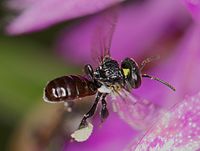
Photo from wikipedia
Animals have developed various drinking strategies in capturing liquid to feed or to stay hydrated. In contrast with most animals, honey bees Apis mellifera that capture nectar with their tongue,… Click to show full abstract
Animals have developed various drinking strategies in capturing liquid to feed or to stay hydrated. In contrast with most animals, honey bees Apis mellifera that capture nectar with their tongue, can deliberately switch between sucking and lapping methods. They preferentially suck diluted nectar whereas they are prone to lap concentrated nectar. In vivo observations have shown that bees select the feeding method yielding the highest efficiency at a given sugar concentration. In this combined experimental and theoretical investigation, we propose two physical models for suction and lapping mode of capture that explain the transition between these two feeding strategy. The critical viscosity, μ*, at which the transition occurs, is derived from these models, and agrees well with in vivo measurements. The trade-off mechanism of honey bee sucking and lapping may further inspire microfluidics devices with higher capability of transporting liquids across a large range of viscosities.
Journal Title: Soft matter
Year Published: 2022
Link to full text (if available)
Share on Social Media: Sign Up to like & get
recommendations!